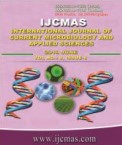


 National Academy of Agricultural Sciences (NAAS)
National Academy of Agricultural Sciences (NAAS)

|
PRINT ISSN : 2319-7692
Online ISSN : 2319-7706 Issues : 12 per year Publisher : Excellent Publishers Email : editorijcmas@gmail.com / submit@ijcmas.com Editor-in-chief: Dr.M.Prakash Index Copernicus ICV 2018: 95.39 NAAS RATING 2020: 5.38 |
Salinity tolerance genotypes is useful to cross with high yielding existing varieties to develop high yield hybrid that can grow in saline soil and saline water conditions. The different species of Brassica namely, B. juncea, B. carinata, B. napus B. campestris var toria were screened for salt tolerance and tolerant genotypes were identified. Comparisons of Brassica species use to identify salinity tolerance species and screening individual genotypes of rapeseed-mustard. A total number of 281 genotypes consisting 225 B. juncea, 34 B. carinata, 18 B. napus, 4 B. campestris var toria were tested for salinity tolerance at levels of 100, 150 and 200 mE concentrations of saline water with distil water used as a control. Saline indices were recorded at seedling stage under lab conditions. Means, standard error and correlation were calculated by Microsoft Excel 2016 and SPSS 16.0, respectively. The two ways positioning hierarchal dendrogram, constellation plot and scatter plot matrix were also made by JMP SAS 25.0 software. The experiment was conducted in ICAR-Directorate of Rapeseed-Mustard Research, Bharatpur, India during 2016 - 2017. The initial results showed that correlations among germination (%), root length (cm) and shoot length (cm) were significant at P < 0.05 and P < 0.01 level under control and saline conditions. Two ways hierarchical cluster analysis of genotypes were grouped into 7 clusters. In these clusters, cluster 5 include 4 genotypes and cluster 6 include 8 genotypes have salinity tolerance than other clusters. In which these genotypes have higher germination (%) with high root and shoot length in lab conditions. In cluster 5 have F3 2(MJA 34/SSR 1-8)-7, F2 2(MJA 39/MJR 14)-6, F2 13-4, F2 12-2-1(4-9-2/EC 597309) genotypes and cluster 6 have F3 12-2-5(KLM 227/EC 597313), F2 13-3, F3 3(EC597309/NUDHYJ 3/RL 1359)-3 very early, F4 4(DMH 1)-3, 06-01-2006, F3 2(MJA 34/SSR 1-8)-6, HB 9910, 13-6-0, F3 7-4 genotypes salinity tolerance among whole collection. It will be necessary to screen these genotypes in field conditions for more precise results. Amphiploids species B. juncea and B. carinata significantly tolerance with high germination (%), high relative shoot and root length than B. napus and diploid species, B. campestris var toria. It is inferred that amphiploids species are comparatively salt tolerant than their diploid relatives. Twelve genotypes namely from F3 2(MJA 34/SSR 1-8)-7, F2 2(MJA 39/MJR 14)-6, F2 13-4, F2 12-2-1(4-9-2/EC 597309), F3 12-2-5(KLM 227/EC 597313), F2 13-3, F3 3(EC597309/NUDHYJ 3/RL 1359)-3 very early, F4 4(DMH 1)-3, 06-01-2006, F3 2(MJA 34/SSR 1-8)-6, HB 9910, 13-6-0, F3 7-4 were identified as high salinity tolerance from this evaluation.
 |
 |
 |
 |
 |